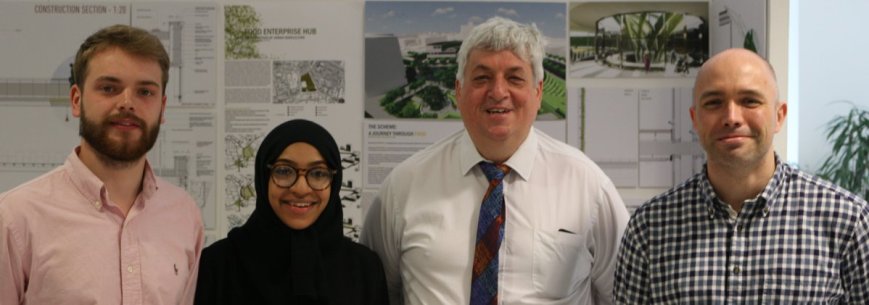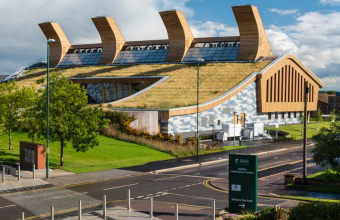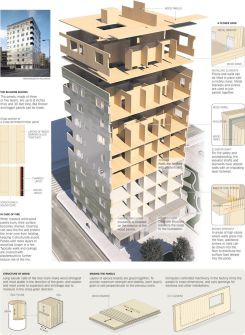
Architectural Technology students at Nottingham Trent University are exploring developments that could see changes to the way our buildings operate and our streets look within a few years.
Cross Laminated Timber
Easy to forget that many nations still work with timber to build homes and offices.
Arguably, we’ve had a downer on timber, and straw, ever since Three Little Pigs.
Yet wood can be incredibly strong – remember the WWII fighter-bomber called the Mosquito? Made out of plywood.
 Cross Laminated Timber is the latest way of creating a strong material to build with, and can be as strong as concrete reinforced with steel. Gluing and pressing lumps of work in alternate directions to create a medium that is being used to create 8 or so story buildings in London and elsewhere, and is being planned to build much higher buildings in China. The Sustainable Chemistry building at University of Nottingham’s Jubilee Campus has been made using CLT.
Cross Laminated Timber is the latest way of creating a strong material to build with, and can be as strong as concrete reinforced with steel. Gluing and pressing lumps of work in alternate directions to create a medium that is being used to create 8 or so story buildings in London and elsewhere, and is being planned to build much higher buildings in China. The Sustainable Chemistry building at University of Nottingham’s Jubilee Campus has been made using CLT.
Large components / panels designed on computer and cut in factories before being delivered to site for fast assembly on site – which may well have worked to advantage on Arkwright Walk in The Meadows since residents have suffered from weeks of limited access.
 Building using CLT currently can cost as much as more traditional buildings cos you still have to prepare the site and connect the site, and cos considerable effort goes into designing and manufacture off-site.
Building using CLT currently can cost as much as more traditional buildings cos you still have to prepare the site and connect the site, and cos considerable effort goes into designing and manufacture off-site.
Challenges will include reputation on appearance (current wooden panels are often allowed to go grey and appear drab), strength, pre-fabricated buildings, and on fire risk (sprinklers systems and treatment are the lines of defence), being part of a first wave on a new technology and the actual challenge – getting owners to embrace the more frequent maintenance measures such as re-applying water-proofing measures. Decoration with external boards are often part of the design – or use other materials like brick panels – but a defining style might also be a challenge (or an opportunity).
CLT is made from green materials, that have captured carbon dioxide, unlike concrete and steel which increase its emissions.
One factory unit in Greater Nottingham has already started manufacturing panels to allow construction of 2 or 3 floor homes.
Urban Farming, including Hydroponics and Tall Gardening.
First mentioned to me by a rep of Notts Farmers who I met at the County Show, hydroponics is a water based farming that uses 70% less water than conventional farming, I think in part cos of using gels.
Requiring upfront investment and a level of expertise, it can be used underground as well as alongside buildings. Can grow certain types of vegetables, and the remaining mass/media can be a fuel or be digested to produce natural gas.
Farming can be encouraged in the design of the building, or take advantage of existing spaces, such as perhaps the 600 or more caves underneath Nottingham city centre. Like the growing trend in farming, companies could hire the space to grow the food.
I understand hydroponics are being developed in Birmingham.
Tall gardening is a variation on this, but are more effective than the green walls that can be seen off Maid Marian Way in Nottingham.
Nottingham has a reputation for urban gardening – often winning “In Bloom” awards – but urban farming would require a step change and need to be commercially viable.
Ground Source Heat Pumping, and Storage.
That 30 feet or so underground, it’s always 12 degrees Centigrade, and therefore a natural place for heat pumps to draw heat from to warm buildings in Winter, and to send heat to so as to extract heat from buildings in Summer, has been compromised by how it seems to be rarely done in practice.
A frequent solution has included laying arrays of piping before a building has been constructed. It’s a bit of a retrofit if the building already exists.
What may be overlooked is the potential to use piles to support buildings as the basis of a heat pumping solution, storing heat from systems such as district heating schemes in the Summer, and reducing the peak load on a heating system during the Winter. Or, even more dramatically, to send to “reservoirs” of water underground, such as disussed coal mines. (There’s a trial taking place in Glasgow.)
Qualifications.
I need to get this article reviewed by others more in the know, as well as improving the grammar.
There may be other innovations to include, such painting roads white to reduce city centre ovens, and consequent demands on air cooling systems (though this may not be needed in Nottingham. Other innovations, such as glass roads, using excesses of recycled glass, especially for car parks and cycle paths, with underground lighting and lining, have perhaps already failed to take off.
Gist is, if anything can be foreseen to be the standards of 10 years time, now is the time to invest, both in setting new standards and in creating the capacity to manufacture locally for local jobs.
TO BE REVIEWED AND UPDATED.